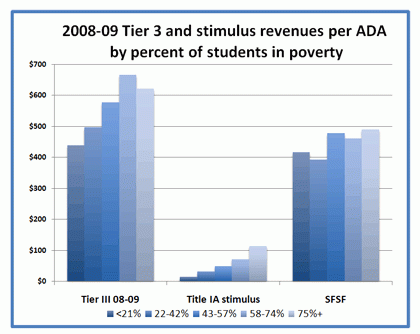Poorer Districts Face Bigger Stimulus Funding "Cliff"

The recent release of the Interim Status Report on the financial health of districts can’t be surprising to anyone. 13 districts received a negative certification, meaning the “district will be unable to meet its financial obligations for the remainder of the current year or for the subsequent fiscal year.” Another 97 districts were determined to be in danger of failing to meet financial obligations for the current or two subsequent fiscal years, earning them a qualified certification. That is down slightly from 114 districts last year but according to the CDE, “The numbers used to arrive at the certifications preceded the Governor's Budget proposal, and therefore do not reflect the potential loss of temporary tax revenues, and the new proposed multi-billion dollar funding deferral.” Presumably, the number of districts unable to meet their financial obligations is only going to go up if district revenues continue to fall.
Although I’m not entirely sure I understand exactly what funding streams are affected by the governor’s proposal, certainly one big pot of money that will be going away shortly (or that is already gone in many districts) is federal stimulus funding (i.e., funds allocated through the American Recovery and Reinvestment Act). ARRA funds were allocated through a few different programs but the biggest were the State Fiscal Stabilization Fund (SFSF), which back-filled reductions in district revenue limits and certain categorical programs, Title I, parts A and D, and IDEA, part B (Individuals with Disabilities Education Act). The funds were mostly sent to districts in fiscal years 2008–09 and 2009–10; they can be carried over from year to year but are supposed to be completely spent by end of September, 2011.
It is pretty clear that some districts benefited more from stimulus funding than others. In a recent study looking at categorical and federal stimulus funds, I showed the distribution of revenues for Tier 3 categoricals, Title IA stimulus and SFSF. Figure 3 in the brief (shown above) shows 2008–09 revenues per ADA for districts with varying levels of students in poverty, as measured by the percent of students in the federal reduced and free lunch program. What we see is that districts with more poor students receive more funds from Tier 3 programs but also more stimulus funds. This is not surprising as these districts have more Title I students and part of the SFSF revenues were specifically intended to offset the cuts in Tier 3 programs. But since the Tier 3 cuts are on-going and the stimulus funding is not, the implication is that districts with more poor students will be disproportionately hurt by the loss of stimulus funds. Given the research showing that students in poverty need more resources than more affluent students, this is a particularly troubling pattern.



